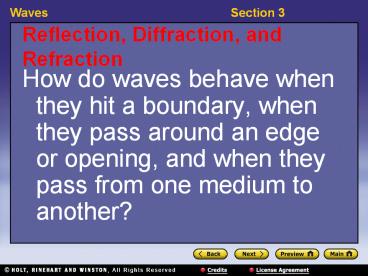Reflection, Diffraction, and Refraction - PowerPoint PPT Presentation
1 / 15
Title:
Reflection, Diffraction, and Refraction
Description:
Reflection, Diffraction, and Refraction How do waves behave when they hit a boundary, when they pass around an edge or opening, and when they pass from one medium to ... – PowerPoint PPT presentation
Number of Views:394
Avg rating:3.0/5.0
Title: Reflection, Diffraction, and Refraction
1
Reflection, Diffraction, and Refraction
- How do waves behave when they hit a boundary,
when they pass around an edge or opening, and
when they pass from one medium to another?
2
15-3-1 Reflection, Diffraction, and Refraction,
continued
- reflection the bouncing back of a ray of light,
sound, or heat when the ray hits a surface that
it does not go through
3
15-3-2 Reflection, Diffraction, and Refraction,
continued
- Examples
- The reflection of light waves from a mirror or
water waves reflected when they hit the side of a
boat.
4
15-3-3 Reflection, Diffraction, and Refraction ,
continued
- diffraction a change in the direction of a wave
when the wave finds an obstacle or an edge, such
as an opening
5
15-3-4 Reflection, Diffraction, and Refraction ,
continued
- Examples
- Water waves diffract around a block in a tank of
water and sound waves passing through a door
diffract.
6
15-3-5 Reflection, Diffraction, and Refraction ,
continued
- refraction the bending of a wavefront as the
wavefront changes speed as it passes from one
medium to another at an angle
7
Interference
- What happens when two waves are in the same
location?
8
15-3-6 Interference
- interference the combination of two or more
waves that results in a single wave
9
15-3-7 Interference, continued
- constructive interference an increase in
amplitude due to a superposition of two or more
waves that produces an intensity equal to the sum
of the intensities of the individual waves
10
15-3-8 Interference, continued
- destructive interference a decrease in amplitude
due to a superposition of two or more waves that
produce an intensity equal to the difference of
the intensities of the individual waves
11
Interference, continued
12
Standing Waves
- How are standing waves formed?
13
15-3-10 Standing Waves
- standing wave a pattern of vibration that
simulates a wave that is standing still
14
15-3-11 Standing Waves, continued
- Each loop of a standing wave is separated from
the next loop by points that have no vibration,
called nodes.
15
15-3-12 Standing Waves, continued
- Midway between the nodes lie points of maximum
vibration, called antinodes.































